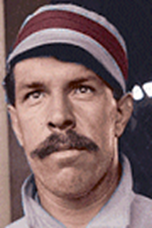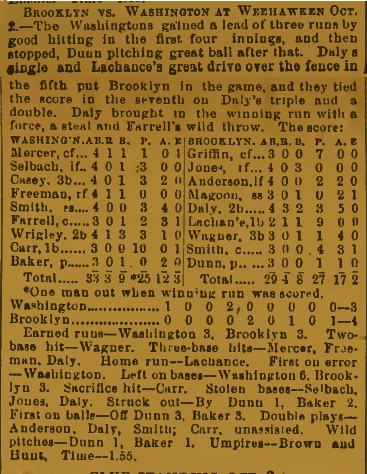Historical Hitter October 2 1898: Candy La Chance

It’s October, which means that it’s the month that belongs to the Yankees. Baseball history contains more references perhaps to the Yankees on this day than any other team, it’s either the Yankees have just won, or somebody has done a superhuman effort and the Yankees lost.
Such superhuman events are Sandy Koufax’s 15 strikeouts in leading the Dodgers to victory 5-3 in game one of the 1963 World Series. In 1920, In 1908 Otis Clymer hit for the cycle in a Senators victory against the New Yorkers 12-2. (The only consolation is the team is still called the Highlanders.)
The Yankees swept the Cubs and won the 1932 World Series this day. A few days after the Babe “called” his shot, he was hit by a pitch. Tony Lazzeri provided the firepower with two home runs. In 1966, the opposite occurred, the Yankees finish last in the American League.
1978: Bucky “&^@$%#” Dent, as they say in Boston.
The same result occurred for Boston in 1949, 1921, just to name a few.
But there are more teams than just the Yankees. How about the Old Nationals from Washington and Brooklyn Bridegrooms playing on Sunday October 2, 1898 in Weehawken, NJ? Why Weehawken? It’s more famous for being the spot were Aaron Burr shot Alexander Hamilton in their infamous duel of 1804.
Weehawken was the place for lawless baseball in the 1890’s. While New York State Court was upholding the State’s Blue Laws against baseball game on Sunday, the entrepreneurs of New Jersey seized the opportunity and behold baseball games were staged on Sunday for much profit. Playing in New Jersey, across the Hudson from Manhattan, was not a new concept as Elysian Fields in Hoboken was the site of the first game played with the “New York” rules in 1845.
The field formerly known as the Weehawken Cricket Grounds is still in existence, now known as the West New York Baseball Grounds. In 1898-99 The Giants and Dodgers played a total of seven official games there. Sporting Life reported on other exhibition games there always played on Sunday. The team included the old St. Louis Browns, and an end-of -season ‘world series’ exhibition featuring Baltimore and Boston. This is not the only foray into New Jersey for Brooklyn, they played a series of home games in Jersey City in the 1950’s.
Today’s batting heroics come from a glorious Sunday afternoon October 2, game played by two National league teams that had a combined record of 104 wins and 192 losses. It was battle between the 10th and 11th place teams, the Bridegrooms of Brooklyn and the Nationals of Washington. Despite their standings some 2000 strong from Brooklyn made the ferry trip and were in attendance.
 The batting hero went by the name of Candy La Chance. He was a mountain of man and noted for fighting anyone, anytime if his honor was at stake. Jack Kavanagh noted that La Chance challenged Rube Waddell once to a wrestling match before a game. An hour into the grappling contest, Waddell pined La Chance and then went out and pitched a shutout. Meanwhile, Candy was on the bench nursing his pride and injured shoulder. He was born George Joseph La Chance, and was given the nickname ‘Candy’ for eschewing tobacco and preferring peppermint hard candy. We also know that Candy was nickname for good ball players in the 19th Century, sort of like “he’s dandy Candy.” The terms, “muffin” and “cake” used in William Thayer’s “Casey at the Bat” refer to weak hitting players.
The batting hero went by the name of Candy La Chance. He was a mountain of man and noted for fighting anyone, anytime if his honor was at stake. Jack Kavanagh noted that La Chance challenged Rube Waddell once to a wrestling match before a game. An hour into the grappling contest, Waddell pined La Chance and then went out and pitched a shutout. Meanwhile, Candy was on the bench nursing his pride and injured shoulder. He was born George Joseph La Chance, and was given the nickname ‘Candy’ for eschewing tobacco and preferring peppermint hard candy. We also know that Candy was nickname for good ball players in the 19th Century, sort of like “he’s dandy Candy.” The terms, “muffin” and “cake” used in William Thayer’s “Casey at the Bat” refer to weak hitting players.
LaChance was a switch hitter and played 12 years in the majors, Brooklyn (1893-1898), Baltimore (1899), Cleveland (1901) and Boston Americans (1902–05). He had a career batting average of .280, played in 1265 games had 1380 hits. The power stats include 198 doubles, 87 triples, 39 home runs with a dead ball era OPS+94. Baseball-reference.com has him ranked at 1247. He led the league in strikeouts in 1898 and then in 1903 led the American League in games played.
 LaChance hit a two- run homerun in the bottom of the fifth that helped lead the Bridegrooms to victory. It was described as an attention garnering “great drive over the fence.” Later, the winning run was scored in typical dead-ball era style: a force-out, stolen base, and a throwing error.
LaChance hit a two- run homerun in the bottom of the fifth that helped lead the Bridegrooms to victory. It was described as an attention garnering “great drive over the fence.” Later, the winning run was scored in typical dead-ball era style: a force-out, stolen base, and a throwing error.
A great home run aside, Candy’s time in Brooklyn were numbered, the fans were losing confidence in him and with the team’s poor Mets-like performance. John B. Foster wrote a Sporting Life story entitled: “The President’s Management Open to Criticism -Local Public Becoming Alienated -The Need of the Team and the Chances For Satisfying It.”
The team’s supporters have lost the taste for this Candy, as it is written:
[T]he cranks have lost all confidence the better for everybody. LaChance is not the only player on the team who has been criticized, and not the only player whom the local cranks believe has passed the days of his usefulness. What the city wants is a wide and general sweep, paying no attention to the matter of personal friendship, but putting the team in condition to win sometime.
After two single seasons stays in Baltimore and then Cleveland under his belt, LaChance’s career was restored and re-invigorated with the newly formed Boston Americans. His size, exceptional fielding, good clubhouse demeanor, and New England roots helped make him a media favorite. He was quoted as saying, “I think Boston is the finest city in the country to play ball in.”
Bill Nowlin in Candy’s SABR Bio Project noted that LaChance was one of the best-fielding first basemen of the time. The 1902 Reach Base-Ball Guide described LaChance’s fielding as:
…he is a wonder in fielding bad throws and in handling balls where a long reach is required, and is sure on fly balls.”
Nowlin further quoted Boston Globe writer and a past batter of the day, Tim Murnane, described his good fielding with a simple phrase: “LaChance is a red ace.”
After the successful 1903 & 1904 seasons in Boston, in which La Chance was named the “King of [the] Naugatuck Valley” by the Boston Globe Christmas edition. While his career was clearly on the downturn he was a preferred teammate and good clubhouse character guy. The 1904 Boston Globe described the positive relationship of LaChance with his manager Tom Collins and team as the following:
Collins believes in harmony, and knows that his big first baseman does the best he knows how at all times. LaChance is kind hearted and obliging to the other members of the team, and all feel kindly toward him. The team being exceptionally strong, it can afford to keep one or two players not in the top-notch class, and in this way make the other players feel doubly secure.
In 1905 age caught up with La Chance, after a rough spring were he hit just .147 he was given his unconditional release on May 9th. This release which was uncommon at the time allowed La Chance to continue playing ball in the minors. Although he had offers to play in the Midwest, his New England roots were strong and he found the team in Montreal to his liking. By 1908, the 38-year old La Chance finished up his professional minor league career in the Class B Connecticut State League with the nearby Waterbury Authors. After a stint as an umpire, his baseball was limited to playing on local semi-pro teams. He took the job his father had: the night watchman at Waterville’s brass factory, the Chase Metal Works. He died 1939 due to poor health and is buried in Waterville Cemetery.
[divider]
Sources:
Pinch Hit Homers in the World Series
Johnny Mize http://www.retrosheet.org/boxesetc/1952/B10030NYA1952.htm
Yogi, 1947: http://www.retrosheet.org/boxesetc/1947/B10020BRO1947.htm
See home page for Baseball-alamanac.com for George Shuba
www.georgeshuba.com
George “Candy” La Chance
http://sabr.org/bioproj/person/5eeca431 by Bill Nowlin SABR BioProject.
Baseball-reference.com
Baseball-almanac.com
Sporting Life, Volume 31, No. 20, August, 6 1898 Vol 32 No 3 October 8, 1898
